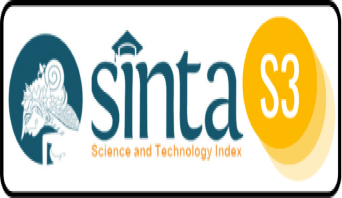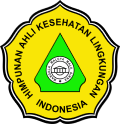DAYA SERAP ARANG AKTIF TONGKOL JAGUNG SEBAGAI MEDIA FILTER DALAM MENURUNKAN KADAR BESI (Fe) PADA AIR
DOI:
https://doi.org/10.26630/rj.v14i1.2170Keywords:
Corn cobs, Activated carbon, Iron, FilterAbstract
Corn cobs are a solid waste that has not been maximally utilized and can pollute the environment. Corn cobs can be used as activated charcoal because they contain cellulose (41%) and hemicellulose (36%). The research objective was to determine the ability of corncob activated charcoal to reduce water iron (Fe) content in water.
True Experiment research with pretest-posttest design with control group design with 6 repetitions. The mass variation of corn cobs activated charcoal in the filter media used was 2,920 gr, 4,380 gr, and 5,840 gr. The number of samples of the artificial iron solution used for each repetition of each of the variations in the mass of the adsorbent was 7 litres so that the total required was 168 litres. The data obtained were analyzed using One Way Anova.
The results showed the levels of Fe after treatment in the mass variation of activated charcoal cob 2920 g was 2.55 mg / L, at 4,380 g mass was 1.67 mg / L, and in the mass 5.840 g was 0.64 mg / L. The highest reduction efficiency in iron content was in the mass of 5,840 grams which was able to reduce Fe levels up to 85.70%.
This study proves that activated corn cobs can be used as an absorbent to reduce levels of iron (Fe) in water.Â
References
Agustina, S. dan Fitrina, A. 2018. Proses Peningkatan Luas Permukaan Karbon Aktif Tongkol Jagung. Seminar rekayasa teknologi semrestek, e-ISSN : 2, hlm: 440–446.
Antonia Nunung Rahayu dan Adhitiyawarman. 2014. Pemanfaatan Tongkol Jagung Sebagai Adsorben Besi Pada Air Tanah. Jurnal Kimia dan Kemasan, 3(3), hlm: 7–13.
Joko, T . 2010. Unit Produksi dalam Sistem Penyediaan Air Minum. Yogyakarta: Graha Ilmu.
Kusumaningrum, W. dan Indah Nurhayati. 2016. Penggunaan Karbon Aktif Dari Ampas Tebu Sebagai Media Adsorbsi Untuk Menurunkan Kadar Fe (Besi) dan Mn (Mangan) Pada Air Sumur Gali di desa Gelam Candi. Jurnal Teknik Waktu, 14(01), hlm: 1–7.
Mantong, J. O., Argo, B. D. dan Susilo, B. 2018. Pembuatan Arang Aktif Dari Limbah Tongkol Jagung Sebagai Adsorben Pada Limbah Cair Tahu. Jurnal Keteknikan Pertanian Tropis dan Biosistem, 6(2), hlm: 100–106.
Martina, D., Hastuti, R. dan Didik Setiyo Widodo. 2016. Peran Adsorben Selulosa Tongkol Jagung (Zea mays) dengan Polivinil Alkohol (PVA) untuk Penyerapan Ion Logam Timbal (Pb2+ ). Jurnal Kimia Sains dan Aplikasi, 19(3), hlm: 77–82.
Meisrilestari, Y., Khomaini, R. dan Wijayanti, H. 2013. Pembuatan Arang Aktif dari Cangkang Kelapa Sawit dengan Aktivasi Secara Fisika, Kimia dan Fisika dan Kimia. Jurnal Konversi, 2(1), hlm: 45–50.
Ningsih, D. A. dan Said, I. 2016. Adsorpsi Logam Timbal ( Pb ) Dari Larutannya Dengan Menggunakan Adsorben Dari Tongkol Jagung. Jurnal Akademika Kimia, 5(2), hlm: 55–60.
Nuuruningrum, I. 2017. Pemanfaatan Limbah Tongkol Jagung (Zea mays Linn) Sebagai Arang Aktif dalam Menurunkan Kadar Besi (Fe) Air Sumur Gali Warga di Kelurahan Jati Utomo Kecamatan Binjai Utara Tahun 2017. Skripsi Fakultas Kesehatan Masyarakat, Universitas Sumatera Utara.
Yevitasari, D. C. 2013. Keefektifan Ketebalan Karbon Aktif Sebagai Media Filter Terhadap Penurunan Kadar Besi (Fe) Air Sumur. Artikel Publikasi Ilmiah, Program Studi Kesehatan Masyarakat, Universitas Muhammadiyah Surakarta.
Yuningsih, L. M., Mulyadi, D. dan Kurnia, A. J. 2016. Pengaruh Aktivasi Arang Aktif dari Tongkol Jagung dan Tempurung Kelapa Terhadap Luas Permukaan dan Daya Jerap Iodin. Jurnal Kimia VALENSI, 2(1), hlm: 30–34
Downloads
Published
How to Cite
Issue
Section
License
Copyright (c) 2020 Ruwa Jurai: Jurnal Kesehatan Lingkungan

This work is licensed under a Creative Commons Attribution-NonCommercial 4.0 International License.

Ruwa Jurai: Jurnal Kesehatan Lingkungan is licensed under a Creative Commons Attribution-NonCommercial 4.0 International License.
Authors who publish with this journal agree to the following terms:
- Authors retain copyright and grant the journal right of first publication with the work simultaneously licensed under a Creative Commons Attribution-Non Commercial License that allows others to share the work with an acknowledgment of the work's authorship and initial publication in this journal.
- Authors are able to enter into separate, additional contractual arrangements for the non-exclusive distribution of the journal's published version of the work (e.g., post it to an institutional repository or publish it in a book), with an acknowledgment of its initial publication in this journal.
- Authors are permitted and encouraged to post their work online (e.g., in institutional repositories or on their website) prior to and during the submission process, as it can lead to productive exchanges, as well as earlier and greater citation of published work.









